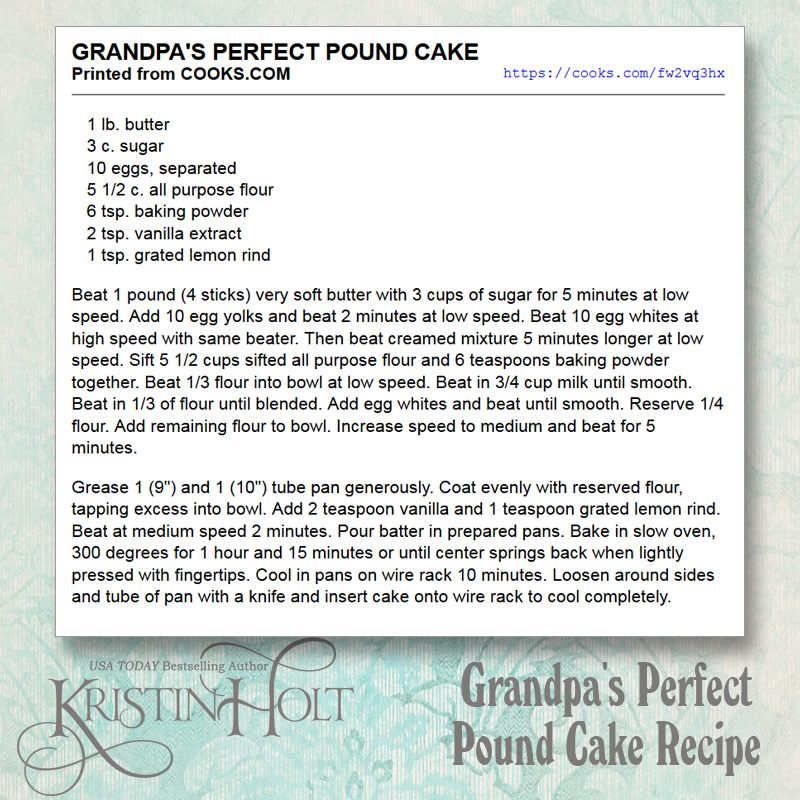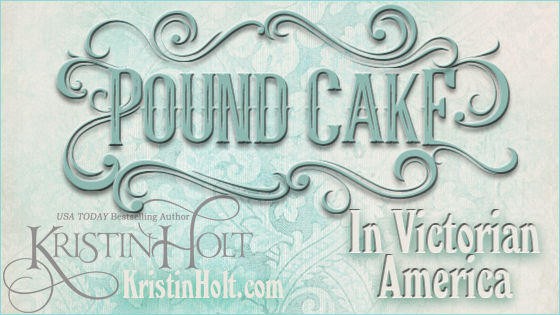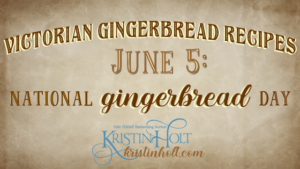Pound Cake in Victorian America
Pound Cake in Victorian America
.
Oooh, delicious! Pound cake has been a favorite among American bakers for far longer than you might think. Pound Cake in Victorian America? Yes! The recipe(s) were a “hand-me-down” from earlier generations.
.

Photograph of a loaf Pound Cake cut into slices upon a serving plate. Photograph courtesy of Delish.com.
.
According to Our State, pound cake has been around since the 1700s. “Pound Cake” was the name, and remembering the ingredients and measurements was a “gimmick” as most homemakers and cooks did not read or write well. In a time where standard kitchen measures were often in weights (and books provided charts or exchanges), a pound cake called for one pound of each main ingredient. One pound flour, one pound butter, one pound sugar, and one pound eggs.
Throughout the 19th century, pound cakes were often flavored with “a gill of” wine, rose water, vanilla extract, lemon zest, citron (or candied citron), currants, caraway seeds, and raisins. Victorian bakers might add one flavor or a combination.
See my “Nineteenth Century Measurements of Baking Ingredients” near the end of my Victorian Fare: Cookies Article.
.
.
Definitions and Classifications
.
What makes a pound cake different than any yellow cake? All cake recipes are essentially the same: flour, eggs, sugar, butter or oil, flavoring, and sometimes a chemical leavening agent. (We know not all cakes do. See Angel Food Cakes.)
.
.
According to How Stuff Works, pound cakes fall into the “butter cake” category and requires baking powder. But that remains an inadequate answer. What is a pound cake?
“Pound cake” (per Google Dictionary) is a noun of North American origin, spelled either pound cake or poundcake. “A rich cake containing a pound, or equal weights, of each chief ingredient, typically flour, butter, and sugar.
Wikipedia further explains that today “pound cakes are generally baked in either a loaf pan or a Bundt mold, and served either dusted with powdered sugar, lightly glazed, or sometimes with a coat of icing.” To separate the noun’s origin from the recipe’s origin, Wikipedia says pound cake probably came from northern Europe and began in the early 1700s.
.
Vintage Recipes
.
Note: Each pound cake recipe below is tagged with publication and date, and is listed in order by year, oldest to newest.
This fine example is another Pound Cake in Victorian America recipe without instructions and only the barest of bits of information. This standard occurred across the board and throughout the century in newspapers and cook books. Only in the later decades of the century did newspapers request that homemakers provide precise measurements and instructions.
.

1846 recipe for pound cake, published in Miss Beecher’s Domestic Receipt Book Supplement.
.

Pound Cake recipe with minimal information, from The Candiz Sentinel of Cadiz, Ohio. Published May 21, 1851. “Pound Cake.–Three eggs, nine spoons full of butter, three of sugar and three hands full of flour.”
.

Pound Cakes recipe from The Watertown News of Watertown, Wisconsin. November 24, 1880.
.
Note: The following pound cake recipe requires beating for a full hour. By hand.

Recipe for Pound Cake from Our New Cook Book and Household Receipts, published 1883.
.

“The ‘old bachelors’ are making preparations for the picnic ‘pound cake’. Recipes are in great demand at present.” From Thomas County Cat of Colby, Kansas. July 22, 1886.
.

Red Pound Cake Recipe from The Indiana State Sentinel of Indianapolis, Indiana. May 13, 1891.
.

Plain Pound Cake Recipe from The Indiana State Sentinel of Indianapolis, Indiana. May 13, 1891.
.

Hanover Pound Cake recipe, “This is a capital cake, always made in North Germany at Christmas time.” From The Indiana State Sentinel of Indianapolis, Indiana on May 13, 1891.
.

Cheap Pound Cake recipe from The Boston Globe of Boston, Massachusetts on February 15, 1895. Definition of “cheap” in late 19th century was a complimentary term that meant low-priced and affordable.
.
Popularity with 19th Century Bakers
.
Now that we’ve considered the ingredients required for a pound cake (and how easy it is to recall how much of the main ingredients), I believe the answer is a bit self-evident.
19th century bakers would have the main ingredients on hand as staples. As most housekeepers (19th century term for “homemakers”) kept their own chickens where at all possible and outside of cities (a new development late in the century) most households kept a milk cow and churned butter from cream.
To bake a pound cake from ingredients on hand would be simple. Plain pound cake required nothing extra to taste divine. A hint of vanilla or rose water? Extra delicious.
.
Vintage Recipe for Modern Bakers
.
A relatively easy recipe for pound cake, in today’s terms, and with today’s ingredients. Note: this image can be saved, shared, pinned, downloaded, printed, etc. If you wish, follow the cooks.com link and save the recipe in your account. According to reviews, this recipe was originally published in Family Circle Magazine, September 1973.
.

Recipe from cooks.com for Grandpa’s Perfect Pound Cake. Link: https://cooks.com/fw2vq3hx
.
Related Articles
.
.
Updated March 2022
Copyright © 2020 Kristin Holt LC



























